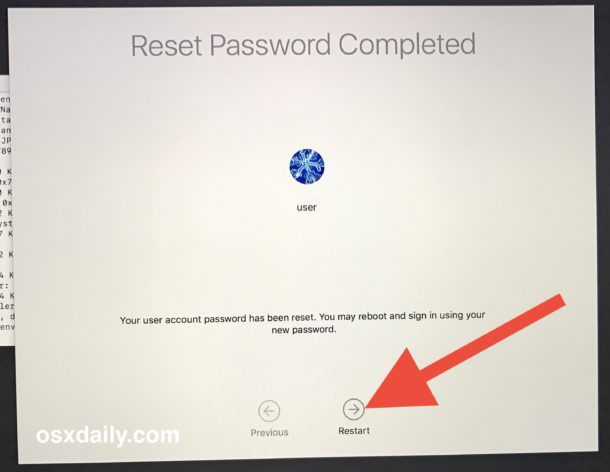Before you begin
Make sure that your Mac is connected to the internet and using macOS Catalina or later. If using an earlier macOS, follow the password-reset steps for macOS Mojave or earlier.

For novice users who wind up at the command line, a very common question occurs with entering passwords into the Terminal, almost always related to sudo and the apparent inability to type a password into the command line of Mac OS X (or Linux for that matter). Which no one seems to know the password for. Even i don't know but i did find a way to fix a failed installation or skipped User creation issue. Step One: Boot up your computer. Step Two: When booted up hold down your 'shift' key and click on the restart button on the bottom right of your screen. If you aren't logged in as an administrator, you're asked to enter an administrator name and password. Click Login Options in the lower-left corner. Choose an account from the “Automatic login” menu, then enter the password of that account. The account is now set up to log in automatically when your Mac starts up. If you enabled this security feature when you first set up your account, you'll be able to use your Apple ID to reset your password. This only works if this feature is enabled to begin with. If you have access to your Mac, you can turn this setting on by clicking the Apple menu and selecting 'System Preferences.'
Choose a reset option from the login window
To see one of the following password-reset options, click the question mark next to the password field in the login window. If you don't see a question mark, enter any password three times.
If you see the option to reset using your Apple ID

- Click the option to reset using your Apple ID, then proceed as follows:
- If your Mac restarts, skip to the next section, “If you see the option to restart and show password options.”
- If your Mac doesn't restart, but immediately asks for your Apple ID credentials, enter that information and click Reset Password.
- If you're asked to create a new keychain to store the user's passwords, click OK to restart your Mac.
- If you're asked to select an admin user you know the password for, click “Forgot all passwords?”.
- If you see a Reset Password window with the option to Deactivate Mac, click Deactivate Mac, then click Deactivate to confirm.
- Enter your new password information, then click Next.
If this window shows multiple user accounts, click the Set Password button next to each account name, then enter the new password information for each account. - When the password reset is completed, click Restart.
If you see the option to restart and show password options
- Click the option to restart and show password reset options, then wait for your Mac to restart.
- You're then asked to take one of these steps:
- Sign in with your Apple ID. You might also be asked to enter the verification code sent to your other devices.
- Enter your FileVault recovery key. You received it when you turned on FileVault and chose to create a recovery key instead of allowing your iCloud account (Apple ID) to unlock your disk.
- Select a user that you want to reset the password for, then click Next.
- Enter your new password information, then click Next.
- When the password reset is completed, click Restart.
If you see the option to reset using your recovery key
- Click the option to reset using your recovery key, then enter your FileVault recovery key. You received it when you turned on FileVault and chose to create a recovery key instead of allowing your iCloud account (Apple ID) to unlock your disk.
- Enter your new password information, then click Reset Password.
If you can't reset your password
Learn what to do if you can't reset your password.
I have a MacBook Pro and every time I leave the computer running for a long period of time, the computer puts itself to sleep and asks a password to wake it up.
Undoubtedly such a password protects my MacBook with the easiest way, and this option is set by default while my MacBook is login with a user password. But it seems troublesome sometimes. And probably it would lock me out of Mac while I suddenly forget Mac password.
So I try to stop OS X from asking for password after waking up from sleep. If you need to do this, you had better make sure your Mac is running in your home network and nobody could use your Mac without permission except you. Otherwise, your Mac will face a security problem.
Let's see how to disable password requirement when waking up Mac from sleep.
Step 1: Click the Apple Menu on your Mac and choose System Preferences.
Step 2: Find and click the option Security & Privacy in System Preferences.
Os X Restarts Asking For Setup User Password Free
Step 3: Click the lock at the left-bottom side to remove with administrator password.
Before changing settings on System Preferences, it is necessary to state you have administrative privileges. So usually the 'require password after sleep' is greyed out while you have not removed the lock on system settings with administrator.
Step 4: Under General tab, uncheck the option 'Require password after sleep or screen saver begins'.
Os X Restarts Asking For Setup User Password Download
Now click Apple Menu Sleep to make your Mac sleep and you can see whether it still requires password after waking up from sleep.
Os X Restarts Asking For Setup User Password
Os X Restarts Asking For Setup User Password Windows 10
Related Articles: